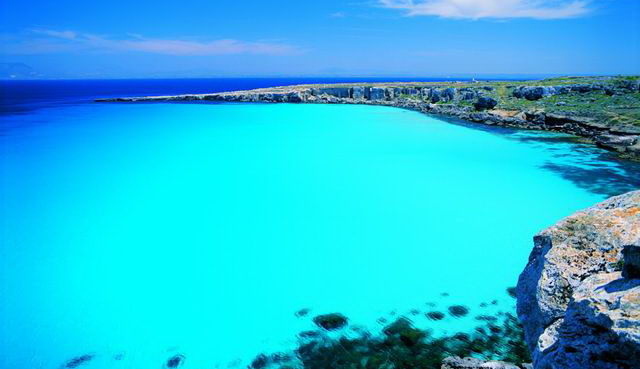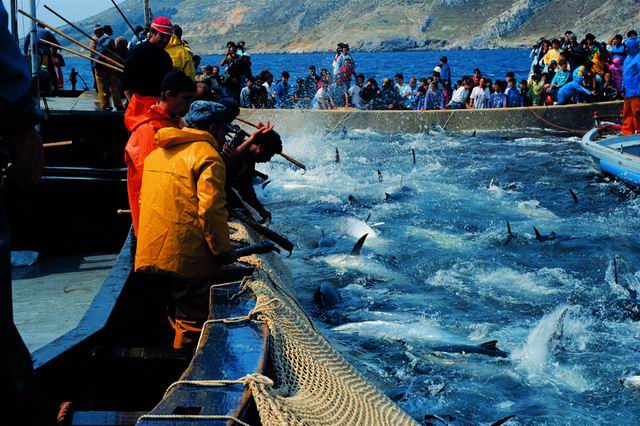| |||||
 |
Favignana | ||||
| The Greek called the island Aegusa but the island was named Favignana after the wind Favonio during the Middle Ages. It looks like a big butterfly alighting peacefully on the Mediterranean waters. | |||||
| Related images (2) |
|
Favignana's waters still evoke historical and mythical episodes. They keep the secrets of ancient battles as the terrible Battle of the Egadi in 241 b.C fought at Cala Rossa by the Romans and the Carthagenians. These waters are still filled with the voices, the songs and the shouting of the seamen engaged in thousands of “mattanze”, the ancient and traditional tuna fishing learned from the Arabs.
Those who reach Favignana fist notice the elegance and the lightness of Palazzo Florio, built around the 1867. The island's prosperity has been linked to the Florio family from the second half of the 19th century till the first decades of this century. The building is certainly a symbol of the island. You can start your tour around the town form here and following the main street you will reach the heart of the island's life, Piazza Madrice, where anything happens. On the right of the square you can penetrate into the S. Anna neighbourhood, the most ancient nucleus of the town, built around the second half of the 17th century. Here, coming the simple houses built in tuff, there are wonderful hypogeum gardens smelling of fruit trees and plants in bloom, scenting of spicy herbs: sage, rosemary, oregano... Just outside the built-up areas, on the north-west side you can explore the S. Nicola area: in the caverns you will find prehistoric graffiti and engravings of the punic period or the ruins of ancient punic or christian tombs. At first the island seems dry, with scarce vegetation and with a flat landscape, but she easily reveals her beauties to those who want to know her, fascinating them with her clear waters, capturing them with the silence of her coves and amazing them with the colours of her countryside. Cala Rossa, seen from the sea or, suddenly, from the top of her rocks is a great emotional experience, a priceless gift of nature; Cala Azzurra, Grotta Perciata, the nice and white Burrone beach, Cala Stornello protected by the small islands of Preveto, Galera and Galeotta, Cala Rotonda inviting and cosy: these are the most patronized places for invigorating bathes. On the northern extremity of the island you will find Punta Faraglione. From the stack, about 34 metres high falling sheer to the sea, starts north-west coast, the most inacessible part of the island, dominated by Montagna Grossa: on its mountainside you will find caves and caverns. But Favignana's real mountain is “il Monte” which divides the island in two parts. On its top there is the S. Caterina Fort, built by Ruggero II the Norman during the 12th century, enlarged and fortified during the 17th century by the Spanish. It seems to keep watch on the people of Favignana and to keep vigil, silently, on that part of sea surrounded by the Egadi Islands as precious jewells of the Mediterranean.
The Tuff Quarries Along with fishing and agriculture tuff has been one of Favignana's most important economic resources. Favignana's tuff, cut in blocks of “cantuni”, was exported all over Sicily and in North Africa. Today these tuff quarries in the north-eastern part of the island make an extremely peculiar and unusual landscape. The open air quarries near S. Nicola testify the fatigues and the hard work of the quarrymen, the tuff cutters and the carters. The great sunken parts near the S. Anna area and in the countryside nearby have become gardens and vegtable gardens. They hide a wonderful hypogean life protected by tuff walls and the passer – by who wish to discover their beauties must look for them. The incredible architectures, almost towers and powerful columns excaveted in the tuff near Cavallo and Cala Rossa, make an unnatural landscape of extraordinary grandeur. An so are the big tunnels excaveted in the rock for hundreds of metres open as enormous mouths, dark and silent, on Cala Rossa's wonderful sea.
The Tunny Fishing
Favignana soon calls for the visitor's attention for its majestic tonnare Florio. Even nowadays by the end of May at dawn you can be woken by the sound of the sea hit by big strokes: they are the tunny fishermen who go to sea for the “mattanza”, tunny killing guided by the Rais. They have performed the same gestures, they have saide the same prayers, they have sung the same “cialome” for centuries. They've got the same tension waiting for fishing time, they satnd the same strain during tunny fishing, they feel the same joy, after hours of exhausting work, going back to the “tonnara” with their boats loaded with big tunnies. These men are conscious of having carried out, once again, an ancient rite, like centuries ago, whose origins are difficult to trace. This rite, carried out every year in spring, is somehow sacred and it marks the island's life, just as it brought about its tichness. The tonnara Florio is a superb example of industrial archaeology and it commands Favignana's port like a cathedral on the sea to which all the islanders related their lives during the island's most splendid period when processing and canning the tunnies followed fishing. And not so far away from the main island, on another small island, Formica, another “tonnara” takes up the island's entire surface and it testifies the abundance of fishing in the past and the importance of the activities linked to it.
Texts and photos, gently permitted, are property of A.P.T. Trapani - www.apt.trapani.it
| |
 |
Search other Guides |
Related arguments
| Favignana |
| Levanzo |
| Marettimo |
| Pantelleria |
| “Via del Sale” - The salt road |
| The hinterland and Belice Valley |
| Through nature between land and sea |
| Trapani between islands and coral |
| Trapani: history, archaelogigy and myth |

 Munch: The Scream Within
Munch: The Scream WithinOne of the year’s most eagerly awaited exhibitions to open its doors on 14 September 2024: Edvard Munch is back in Milan with a major retrospective after a 40-year absence.
 In the garden
In the gardenThe initiative, which is scheduled to run from June 26th to September 13th, 2020, is inaugurating a temporary space for art in Corso Matteotti 5, in Milan, in the very heart of the city.
 Perugia Travel Guide
Perugia Travel GuidePerugia is the chief town of Umbria. This beautiful town is sited on a hill in the middle of a verdant country. His central square is considered one of the most beautiful squares of Italy and history, traditions, art and nature make a unique ensemble in this town as in the whole





